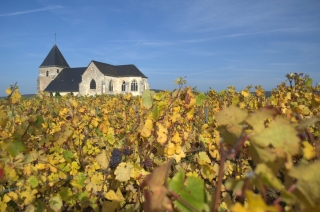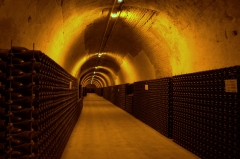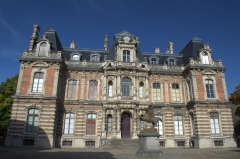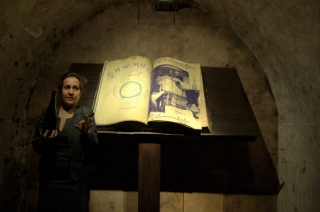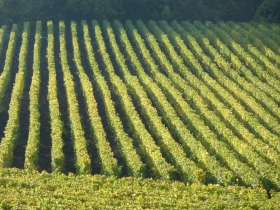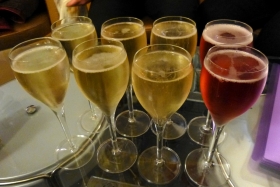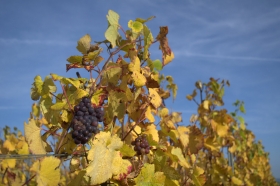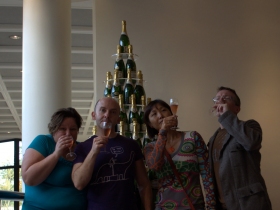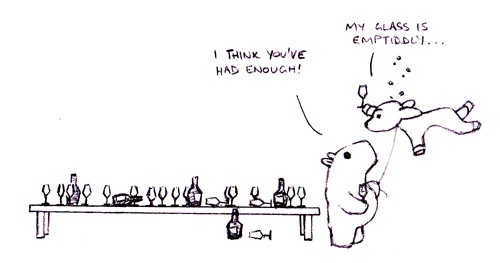Jump in the car, drive down to Dover, get on the ferry and go champagne tasting. Don’t blame me if you come home with three cases of great champagnes your friends have never heard of. And they’ll have cost less than the next eighteen bottles of froth you won’t have to buy in the UK, nicely covering the cost of the ferry and most of the petrol. If you’re diligent like us, you’ll also learn a lot about champagne while sampling more than fifty different bubblies. You may spend a fair proportion of your time a little tipsy. That’s my kind of weekend break.
The champagne region is an area of rolling hills in north-east France, the hilltops covered with bosky forest and every available inch of the slopes clad in noble vines. The town of Epernay is the very epicentre of champagne production, while the handsome city of Rheims is just to the north. So your first choice is whether to base yourself in the town or the city. You could take a rustic retreat among the vines, but then the opportunity to get cheerfully pickled on a wide variety of bubbles is somewhat reduced.
Rheims and Epernay
Rheims, although not surrounded by vines, is actually home to the cellars of most of the biggest champagne names, the “grand marques”. The best and most evocative cellar tours are here, in caves carved out of the chalk beneath the city streets. You’ve also got a nice cathedral, though admittedly we couldn’t find any champagne in it, and plenty of handsome streets lined with shops and places to eat. Oddly, we didn’t find many champagne bars and not for lack of searching. Then again, the locals think nothing of using champagne as a table wine with a light meal.
Epernay by contrast has a number of bars and cellars where you can sample a range of different local champagne producers (the grand marques can go hang, this is where the fun is). There are cellar tours along the Avenue de Champagne, an arrow straight kilometre of road lined with ostentatious villas belonging to various grand marques. Other than that Epernay is actually a rather dull town. In England it would be Bracknell. Champagne is an industry, this happens to be the town at the middle of it, and fate has decreed that it should not have the quaint geography or spiffy chateaux that would combine with the wine to make a really humming tourist spot. C’est la vie.
If you want an all-round weekend break, base yourself in Rheims and take a day-trip to Epernay. If you want to focus on exploring lots of small, independent champagne producers, base yourself in Epernay and take a day-trip to Rheims.
Independent champagnes
You really must take in one or two cellar tours of the grand marques, you’ll learn about how champagne is made and classified and the cellars themselves are spiffy. We’ve enjoyed visiting Mumm, Pommery and especially Ruinart. Mercier was pants. Of course all the tours involve a tasting at the end, with perhaps the chance to try some ruinously expensive fizz that you’d think twice before ordering at home. But I’m much more interested in enthusing about the independents…
Not all champagne is made by Messrs Moet & Chandon. And not all the makers you’ve never heard of are simply mass-producing plonk to slap with a Tesco label. There are small independents by the hundreds making champagnes of real character and quality, never seen beyond the borders of France. I mean it, hundreds. Okay, I’ve wiki’d, there are actually 19,000 champagne producers. Wow.
So pick a sunny day and tour the Marne valley or the Cote des Blancs in your car. Every village has scattered signposts listing a clutch of winemakers, arrows pointing off down little lanes in all directions. Some or all of them will be open for tasting and purchasing. Of course you can’t get round them all (even we couldn’t!) and you’ll have no idea beforehand which ones are good unless you’ve done some detailed research, but that’s half the fun. Don’t choose a Sunday, and Monday is probably dodgy too. Watch out for public holidays. And remain diligently aware of the fact that at 12 midday the restaurants open and everything else closes, wine cellars included. Then at 2pm every restaurant closes and the wine cellars open again. The French want you to run your day their way. Tasting is usually free, no obligation to buy, though some places ask a few euros for the tasting if you don’t purchase anything.
C is for Champagne
For the poor driver of the tour who has been sipping and hopefully spitting all day, allow me to introduce C Comme Champagne (literally “C is for Champagne” – like Sesame Street for grown-ups). This is a bar and cellar in Epernay down a little side-road which absolutely champions the small independent producers. They’ll have nine or so champagnes on tasting, and if that’s not enough then half-bottles for around £8 would open up a lot more options. There are other cellars in Epernay offering other tastings, so you can spread yourself further if you have the time, but C Comme is pretty definitive. Descending into their atmospheric cellar you are surrounded by rack upon rack of independent small-production champagnes, amiable studio photos of the family makers above each rack. There are over 300 champagnes and most bottles will be around the £15-£20 mark.
That’s why you bring your car. Well, the ferry is also cheaper than the Eurostar, but you can’t tour the vineyards without a car and you certainly can’t bring back a few boxes of whichever bubbly wines most tickled your fancy.
Cheers!
There now follows a postscript of pure wine geekery, for those interested…
Understanding champagnes
Champagnes are made out of three grapes: Chardonnay, Pinot Noir and Pinot Meunier. The process is different from ordinary wine in that there are two fermentations: in the first, the grapes are fermented
as usual to make a still white wine; in the second the still wine is fermented in sealed bottles, trapping the fermentation gases which dissolve back into the wine. That’s the fizz. The fermentation sediments are then removed from the bottle by an arcane process called “riddling” but I will you to learn all about that on your cellar tour.In a classically balanced bubbly the Chardonnay provides acidity, brightness and a sense of terroir; Pinot Noir provides body, character and depth; Pinot Meunier provides fruit and balance. But you can enjoy a “blanc de blanc” champagne made with 100% Chardonnay (the only white grape of the three) or a “blanc de noir” made entirely with the two black grape varieties.
Rosé champagnes are typically made by adding a little red wine (also locally made) after the first fermentation, but more rarely the rosé can be made by leaving the red grape skin in during the first fermentation of the champagne wine for a couple of days before removing it. These methods are called “assemblage” and “maceration” respectively.
There are three things contributing to the high price of some champagnes: marque, cru and vintage. As mentioned before, the grand marques have been around a long time and are now world famous brands, so naturally they command a premium price. Of course they produce good champagne, but that doesn’t mean they’re the only ones doing so.
Within the Champagne region there are a handful of villages surrounded by Grand Cru vineyards, a bigger handful having Premier Cru vineyards, and plenty of villages with neither. So of course to be deemed a Grand Cru champagne producer you must make at least one champagne consisting entirely of Grand Cru grapes. This will definitely add some prestige (and price) to your bottle.
Most champagnes are “Réserve”, meaning they are non-vintage as they have been made with wines reserved from a couple of different years and mixed. This mix is important. Each champagne house has its preferred “style” of champagne, yet each year’s harvest may have a
markedly different balance of flavour and acidity. The art is in mixing years to ensure that your standard champagne remains roughly the same. So the attraction of a vintage champagne (labelled “Millésimé” and the year) is that it will represent the true character of that year’s grapes – for better or worse. If the year was exceptional, so will be the price of that vintage.


